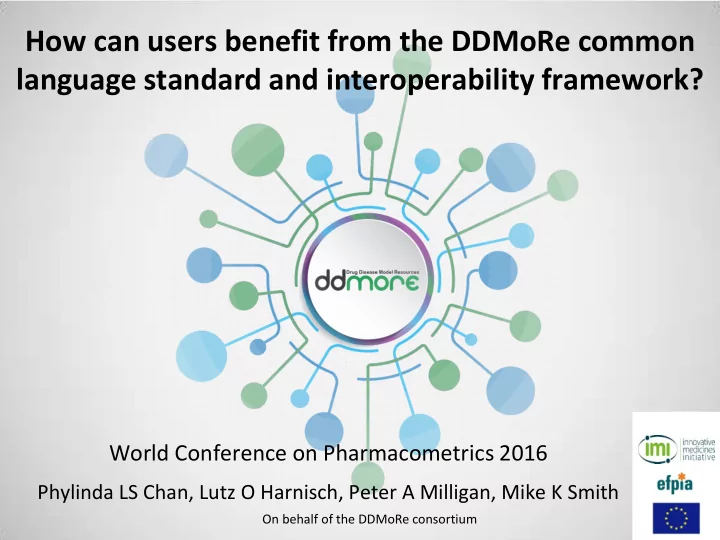

How can users benefit from the DDMoRe common language standard and interoperability framework? World Conference on Pharmacometrics 2016 Phylinda LS Chan, Lutz O Harnisch, Peter A Milligan, Mike K Smith On behalf of the DDMoRe consortium
Typical modelling problems today Limited access to existing modelling knowledge Non-compatible software languages Waste of time and resources, more errors working in a non-integrated/non-compatible environment 2
DDMoRe Consortium in a nutshell 5.5 years Start 23 million 26 March Until Aug € budget partners 2011 2016 3
4
DDMoRe’s Vision Improve quality, efficiency and cost effectiveness of Model-Informed Drug Discovery and Development (MID3) and therapeutic use 5
DDMoRe Platform: “Step by step” Scientific Question Task & Workflow “User perspective “ (June 2016)
DDMoRe Platform: “Step by step” Executable files “Task manager” 8 “User perspective “ “Integration manager” “Translator” (June 2016)
DDMoRe Platform “User perspective “ “User perspective “ (July 2016) (July 2016)
PharmML & SO – Big Picture Pharmacometric Markup Language & Standardized Output
MDL – ProbOnto 11
Model Description Language Structure 12
Model Description Language Structure 13
Modularity – example workflow ▪ Estimation = Data + Parameters + MODEL + Monolix Task Properties ▪ Bayesian estimation = Data + Priors + MODEL + BUGS Task Properties ▪ VPC = Data + Final Parameters + MODEL + NONMEM Task Properties ▪ Prediction / simulation = Design + Final Parameters + MODEL + Simulation Task Properties ▪ Optimal design / evaluation = Design + Final Parameters + MODEL + PFIM / PopED Task Properties 14
MDL – How is it different? Definition of dataset variables and their use in the model DATA_INPUT_VARIABLES{ ID : { use is id } TIME : { use is idv } WT : { use is covariate } AGE : { use is covariate } SEX : { use is catCov withCategories{female when 0, male when 1} } AMT : { use is amt, variable = GUT } DVID : { use is dvid } DV : { use is dv, define={1 in DVID as CP_obs, 2 in DVID as PCA_obs} } MDV : { use is mdv } }# end DATA_INPUT_VARIABLES 15
MDL – How is it different? ▪ To support interoperability , some relationships need to be more explicit (when they can be)... 𝛾 𝐷𝑀 𝛾 𝐷𝑀 log 𝐷𝑀 𝑗 = 𝑚𝑝 𝐷𝑀 × 𝑋𝑈 𝐷𝑀 𝑗 = 𝐷𝑀 × 𝑋𝑈 × 𝑓 𝜃 𝑗 + 𝜃 𝑗 70 70 INDIVIDUAL_VARIABLES { CL : { type is linear , trans is ln, pop = POP_CL, fixEff = [{ coeff =BETA_CL_WT, cov =logtWT}] , ranEff = ETA_CL ) ... } # end INDIVIDUAL_VARIABLES 16
MDL – Some things are easier… ▪ MDL uses the ProbOnto knowledge base for statistical distributions used in Random Variable Definitions. MODEL_PREDICTION{ lnLAMBDA = ln(BASECOUNT) + BETA*CP LAMBDA = exp(lnLAMBDA) } RANDOM_VARIABLE_DEFINITION(level=DV){ Y ~ Poisson1( rate=LAMBDA) } OBSERVATION{ :: { type is count, variable = Y} }# end ESTIMATION 17
MDL-IDE Manages all modelling tasks Project explorer Model/script editor where standardized with advanced editing outputs are and syntax checking accessible features Task console (R) 18
Use Cases Demonstrate functionality, model features • Warfarin Pop PK used as the basis. • UseCase10 – 2 distribution compartments • UseCase1 – Structural model with differential • UseCase11 – Poisson count equations • UseCase2 – Analytical solution • UseCase12 – Categorical outcome • UseCase3 – Joint model of PK and PD (>1 outcome) • UseCase13 – Binary outcome • UseCase4 – IV and oral administration • UseCase14 – Time to event (Exact time of event known) • UseCase5 – Covariate models including categorical • UseCase15 – log-transformed DV covariate • UseCase16 – BLQ handling • UseCase6 – Correlation between V, CL, KA • UseCase17 – Steady State PK • UseCase7 – Structural model specified by • UseCase16 – Interpolation of covariates compartments • UseCase19 – L2 handling • UseCase8 – Between-occasion variability • UseCase20 – Transit compartment for absorption • UseCase9 – Infusion rates • UseCase21 – Mixture models • UseCase22 – Complex PK (>1 absorption compartment) • UseCase23 – Conditional observation model Interoperable UseCase Valid MDL In progess 19
Typical modelling problems addressed by DDMoRe products today Limited access to existing modelling knowledge Non-compatible software languages Waste of time and resources, more errors working in a non-integrated/non-compatible environment 21
In Summary In support of MID3, DDMoRe products provide a vital improvement to transparency in model informed decision making, enhancing knowledge-sharing and scientific communication. Deliverables of the DDMoRe project provide • a quantitative framework for prediction and extrapolation, • centred on knowledge and inference generated from integrated models of compound, mechanism and disease level data, • hence improving the quality, efficiency and cost effectiveness of decision making. 22
More information about DDMoRe Official webpage: http://ddmore.eu/ • For updates on project, products, news, newsletters, publications, blog, events, forums, FAQ, etc. • Follow DDMoRe: Twitter Videos: • DDMoRe vision: https://www.youtube.com/watch?v=zxsNOewJ84g • Podcasts: https://www.youtube.com/watch?v=kgGw4uc2hmw • MDL IDE installation: https://www.youtube.com/watch?v=kgGw4uc2hmw • DDMoRe: an introduction and demo (ISOP workshop): https://www.youtube.com/watch?v=7FmrPKAhFKM 23
How do I get started? Drug and Disease Model Repository http://repository.ddmore.eu/ Interoperability Framework • Installation and User Cases: http://ddmore.eu/beta-release-interoperability-framework • MDL User Guide: http://www.ddmore.eu/instructions/mdl-user-guide DDMoRe Foundation • Contact the Board members: Marylore Chenel, Lutz Harnisch, Mats Karlsson, Paolo Magni, Peter Milligan. 24
Participants are a unique combination of model builders, model users, software developers and teachers 25
THANK YOU… 26 On behalf of the DDMoRe consortium
Recommend
More recommend